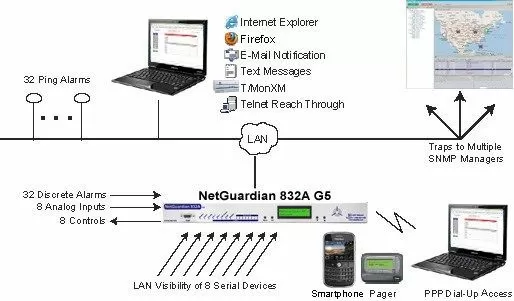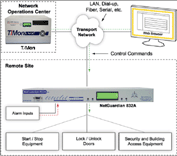Download our free Monitoring Fundamentals Tutorial.
An introduction to Monitoring Fundamentals strictly from the perspective of telecom network alarm management.
1-800-693-0351
Have a specific question? Ask our team of expert engineers and get a specific answer!
Sign up for the next DPS Factory Training!

Whether you're new to our equipment or you've used it for years, DPS factory training is the best way to get more from your monitoring.
Reserve Your Seat TodayRemote Terminal Units (RTUs, sometimes called "Remote Telemetry Units") are essentially your eyes and hands in the field. They're the things that make sure your other things are working. RTUs are devices that monitor the equipment and environment at a site and report back to you, so you know what's going on with your network and equipment. They allow you to leave sites unmanned yet still remain both aware of the state at that site and provide additional methods for control, so you can get more done without driving to a site.
RTU functionality is typically broken into 4 categories:

Monitoring and Notification are the prime functions of any RTU. If you don't know what's going on at your sites, you won't be able to able to respond until you have a problem with your network or process. RTUs are designed to allow you to manage your network proactively. If you respond at the first sign of a problem, it's likely you'll minimize equipment failures and network outages, saving money and keeping your clientele happy.
RTUs typically monitor two different things: discrete alarms and analog inputs. Discrete alarms measure binary conditions and report back on the value: either a condition is present or it isn't, and you can database your RTU to report either way. For example, if you wanted to know when a site is being accessed, if you connect a door sensor to a discrete point, you can set an alarm to go off when the door is opened.
Analog inputs measure a range of either current or voltage and interpret the reading based on a reference. For example, a temperature sensor may use a thermistor that produces a predictable amount of resistance based on its temperature. So, depending on the voltage or current measured by the sensor taking into account thermistor resistance, the RTU will use a formula interpret voltage or current as temperature. Of course, for the end user, it's typically much easier than all of that. You'll usually input reference values based on temperature or current, and your RTU will handle the rest.
Because analog inputs measure a range of values, they can be useful for learning things about your site, like temperature, humidity, wind speed and direction, and fuel levels. While they do provide you with more data, you really only need to know when you have (or are about to have) a problem at your site. For that reason, a good RTU will also allow you to set threshold values for your analog inputs, values at which point your RTU will set an alarm.
But what good is all this data if you never see it, or worse, you're glued to a terminal of scrolling values just to see if you have a problem? The convenience of an RTU is that it provides notifications for discrete and threshold alarms, making network administration and maintenance easier. You need to be able to know what's going on at your sites from wherever you are. For that reason, DPS Telecom recommends the NetGuardian series RTUs, which provide a diverse array of alarm notifications.
When something goes wrong, the NetGuardians can send text, pager, and email notifications with full alarm descriptions and point addresses, so you know what the problem is and where it's occurred. Email notifications even include an acknowledgeable link, so you can let RTU and technicians at your Network Operations Center (NOC) know that you're responding to the alarm. Some RTUs and accessories even provide voice notification for alarms and DTMF access to check up on your site, making network monitoring as easy as making a phone call.
Remote terminal units like the NetGuardian series also report SNMP Traps, so they can communicate with your alarm master station or NOC. While you may want notifications coming directly from your site, you can also use a master station, like the T/Mon Remote Alarm Master, to provide a single, concerted interface for all of your RTUs and display all of your alarms in one place. Since the NOC can also provide notifications, you may simply wish to have your RTUs report SNMP to the NOC and have notifications sent from your Operations Center.
A good RTU should also have some control relays as well, to provide some measure of remote control at a site. The more you can do remotely, the less often you'll actually have to travel out to your site, and cutting down on your travel time will increase your work productivity and decrease costs (and probably stress). A control relay is a small relay circuit that can be operated remotely, whereby closing or opening the circuit performs a function (operates equipment). Control relays can be used to turn on generators, operate HVAC services, turn on and off equipment, lock and unlock doors, and so on.

Sophisticated RTU databasing programs can also allow you to set derived controls, a control command automatically issued under certain conditions. If you have two generators at a site, a primary and a backup, you might derive a control relay to turn on the secondary generator when the analog fuel sensor for the primary generator reads low fuel. Again, this alleviates some of the tedious maintenance duties that would've otherwise required a site visit and wasted time.
Some of the better remote terminal units can be built with additional features that can both help you monitor your site and prevent you from installing additional equipment at greater cost and complication. Many of DPS Telecom's NetGuardian RTUs, for example, can be built with terminal servers, serial ports that provide reach-through access to serial-only devices. This allows you to access equipment you used to only be able to communicate with on site over your network.
Some of the NetGuardian remote terminal units incorporate a switch and custom transport, so can extend LAN access to your fiber, T1, or wireless-only sites without installing a separate switch. You can even incorporate building access functionality into your RTU, using your RTU and master station to control doors at your sites, tracking unauthorized entry just like you would network alarms. This prevents you from using an antiquated lock-and-key system or bothering with separate security systems and services.
As your network grows (either by adding sites or by increasing the available load for each site), so will your monitoring needs. So, when choosing remote terminal units for your network, get something that gives you room to expand, otherwise, you'll likely incur higher costs or blind-spots in your monitoring systems. You don't have to settle for something off-the-shelf either. When ordering an RTU, you can easily have one built to fit your needs. DPS Telecom has a number of build options for each of its RTUs, so you can get the RTU you want, not one that's just good enough.

When ordering an RTU, it's important to get a device that supports your current and forseeable transport, the number of points, analogs, and relays you may need as you expand, along with any additional features you think you might be able to use to help make site maintenance and network administration easier. Expansion and functionality are much more costly to build into the system after you have it installed, so get what you want the first time with a custom-ordered RTU.
Remote Terminal Units help you keep your network online, by alerting you to problems before they result in full-on network outages or equipment damage. Being that they're essentially your eyes and hands in the field, getting the ones that provide you with the most useful information to keep you on top of your network just makes sense.